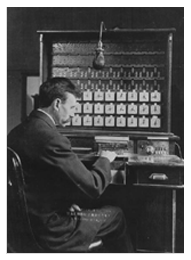end of header
History
You are here: Census.gov › History › Innovations
Innovations

Herman Hollerith, a U.S. Census Bureau employee during the 1880 census, revolutionized a means of coding and tallying information for the 1890 census. Hollerith's venture later became part of what is now the IBM Corporation.
Statistical sampling on some census questions was first introduced in 1940 and has increased with censuses thereafter. The Census Bureau used the first commercial electronic computer, UNIVAC, to compile some of the statistics from the 1950 census. To gather information more efficiently, the census-by-mail and self-enumeration (a household completing a census form on its own without a census-takers assistance) were first used in the 1960 census.
Dealing with ever-increasing data processing complexities, Census Bureau employees created another revolutionary machine known as FOSDIC (Film Optical Sensing Device for Input to Computers) for use in tabulating the 1960 census. After high-speed cameras microfilmed census questionnaires, FOSDIC reads the "fill-in-the-dot" answers directly onto computer tape.
To enhance accuracy in collecting and tabulating census information, the Census Bureau created a new digital mapping and geographic referencing system known as TIGER (Topologically Integrated Geographic Encoding and Referencing). Computer-assisted interviewing was introduced in the early 1990s and the Internet is revolutionizing the way in which information is collected and disseminated in the 21st century.
Comments or suggestions?




